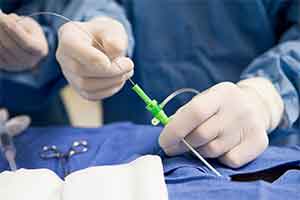Heart catheterization: Change in methods lowers mortality
 The groin is the usual access point for investigating or treating the heart with a catheter, but using the wrist as access point reduces bleeding and lowers mortality. These findings are from an international study with major involvement from the University of Bern published in the Lancet.
The groin is the usual access point for investigating or treating the heart with a catheter, but using the wrist as access point reduces bleeding and lowers mortality. These findings are from an international study with major involvement from the University of Bern published in the Lancet.
About 46,000 cardiac catheterizations are carried out each year in Switzerland; about 22,000 of involve treatments of coronary vessels. The vessels are dilated with a small balloon and supported with a drug-eluting stent so that the heart muscle gets adequate blood supply. The majority of cardiac catheter interventions are still carried out through the femoral artery. Swiss cardiologists choose to insert the catheter through the radial artery less frequently because it is technically more demanding.
However, the new access point is increasingly used – and rightly so, as the largest randomized trial to compare wrist and groin access points to date shows. Access through the wrist can save lives: the novel method reduces risk of bleeding and lowers patient mortality by more than a quarter. The Lancet medical journal publishes this study. ‘The observed reduction in overall mortality is clearly supported by a meta-analysis of all relevant randomized trials’, Peter Jüni, one of the main investigators and new Director of the Institute of Primary Health Care at the University of Bern, says: ‘Therefore we should change the access for coronary angiographies and interventions as soon as possible from the groin to the wrist.’
Lowering mortality at no additional cost
Researchers from the University of Bern have been working on the study together with colleagues from Italy, Spain, Sweden and the Netherlands. The study, which appeared in the journal Lancet, is based on data from about 8,400 patients with acute myocardial infarction, or acute coronary syndrome. After 30 days, 66 patients catheterized through the wrist, and 91 patients catheterized through the groin had died.
‘Earlier studies showed that the risk of bleeding was reduced, but showed no clear advantages in mortality’, the lead author of the study, Dr. Marco Valgimigli of the University of Rotterdam, Netherlands, says. He explains: ‘Our analyses indicate that the reduction in total mortality mainly resulted from reduced bleeding at the access point.’ The study found that access by the groin caused major bleeding at the access site in 43 patients, while access by the wrist lowered that number to 16.
‘Based on these figures, we believe that we can avoid several hundred bleeding events or deaths annually in Switzerland by completely changing access from the groin to the wrist, and this entirely without additional cost», Jüni says. According to him this is an example of a large trial asking a simple question, which has the potential to change practice and significantly improve patient outcomes. The Professor of Primary Health care points out that ‘many of these simple questions are not interesting to the industry, but are of great relevance to our patients. Therefore there is a great need in Switzerland for industry-independent sources of funding for patient-centered clinical research to cover the often considerable costs of such studies, which frequently amount to several millions or tens of millions.’
Change requires appropriate training
Inserting a catheter through he wrist is technically demanding however. The artery on the wrist used for insertion of the catheter is smaller than the artery on the groin, and insertion requires experience and excellent technical skills. ‘It is not possible to make an immediate change, since appropriate training is required’, Professor Stephen Windecker, Chief of Cardiology at the Inselspital Bern, explains. ‘In addition, for technical reasons, a small percentage of patients cannot be catheterized through the wrist, and still has to be treated at the groin.’ Despite this, Windecker, who was not involved in the study, but has main responsibility for the relevant guideline of the European Society of Cardiology, is confident: ‘A turnaround has already started, and it will be boosted by the study results.’
Source: University of Bern
Full bibliographic information:
Valgimigli M, et al, Radial versus femoral access in patients with acute coronary syndromes. Lancet 2015

